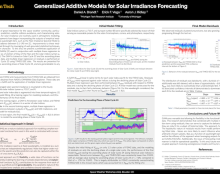Generalized Additive Models for Solar Irradiance Forecasting
Daniel
Brandt
Michigan Tech Research Institute
Poster
A significant number of upper atmospheric models used for space situational awareness, satellite orbit prediction, and satellite collision avoidance rely only on the F10.7 solar radio flux as a proxy for solar EUV input into the upper atmosphere. Methods to forecast F10.7 routinely employ persistence and climatology, but the limitations of these methods, in addition to the inability of F10.7 to comprehensively capture the dynamics of solar EUV at all wavelengths, lead to non-trivial uncertainties in atmospheric models, constraining their effectiveness for use in orbit prediction, especially over timescales on the order of a week or greater. Additionally, continued development of the aforementioned atmospheric models has seen their reliance not merely on F10.7 as a solar EUV driver, but on the solar irradiance in multiple wavelength bands in order to more comprehensively capture the multifaceted solar effects on the upper atmosphere. Forecasting the solar irradiance accurately in multiple bands thus has become of paramount importance for increased space situational awareness. To address this concern, we propose a new and statistically grounded method for forecasting solar irradiance in 59 wavelength bands using Generalized Additive Models (GAMs) parameterized not only on F10.7, but additionally on Lyman-Alpha solar index and sunspot number. We demonstrate the capacity of this approach for short (2-3 days) and medium-term (5-days) irradiance forecasting, and compare the results of the approach to operational paradigms including EUVAC, NEUVAC-59 (an improved version of the solar flux driven by F107), and measured solar irradiance from TIMED/SEE.

Poster PDF
Poster category
Space Weather Policy and General Space Weather Contributions
Meeting homepage